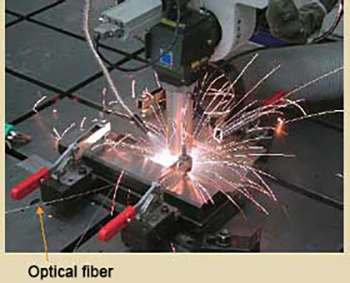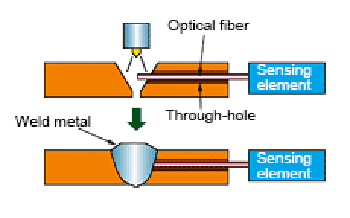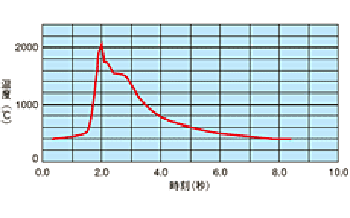Inspection/Measurement
Optical Fiber Thermometer
- Technology for Measurement of Temperature/Cooling Rate of Weld Metal -
In-page menu
Temperature Measurement of Welds by Immersion-Type Optical Fiber Thermometer
-

Photo Temperature measurement in YAG laser welding -

Fig. 1 Principle of measurement -

Fig. 2 Example of measurement results
For evaluation of the properties of welded joints and improvement of joint quality, it is important to know the temperature history during welding. Until now, thermocouples had been used to measure the heating temperature and cooling rate during welding. However, as problems of this method, when a sheath (protective tube) is used, response and accuracy are low, and without a sheath, the contact point is easily melted by the welding arc.
What is an optical fiber thermometer?
The immersion-type optical fiber thermometer was developed to solve the problems mentioned above. Measurements are performed by immersing an optical fiber in the molten metal and transmitting the radiated light captured at the fiber tip to a conversion device. When applied to a weld (Fig. 1), it is possible to continue temperature measurements even if the tip of the optical fiber is melted by the welding arc or beam, because radiated light can be captured by the newly-formed cross section of the fiber. The condition of application to YAG laser welding is shown in the photo, and an example of the measurement results is shown in Fig. 2. Changes in temperature during rapid heating and cooling during welding are measured in the form of an attractive profile. During cooling, the fact that temperature decrease stops while the molten pool is passing through the measurement point can be clearly observed.
Development History and Features
Temperature measurement by optical fiber is a technology which was originally developed around 1995 for measurement of the temperature of molten metal in the blast furnace and other process in the steel works. This technology was marketed by JFE Mechanical Co., Ltd. for use in temperature measurement of casting ladles, and nearly 100 units have been sold to date. As an applied technology, JFE-TEC and JFE Mechanical jointly developed and applied a practical temperature measurement technology for welds, including during solidification and cooling. This device greatly improves accuracy, response and reproducibility in temperature measurements of welds in the high temperature region up to 2000℃, and is currently attracting attention from a variety of fields. This technology has a long record of use to date, including universities, research institutes, automobile makers and others, and is the object of high expectations as a method for measuring basic data for study of heat input/interpass temperature limits and reduction of residual stress in welding, and for FEM analysis of welding deformation, etc.
Features of Optical Fiber Thermometer
(1) Possible to continue measurement even in case of contact with arc
Even if the tip of the optical fiber is melted by the welding arc or beam, it is possible to continue temperature measurements because radiated light is captured by the new cross section.
(2) High accuracy: Emissivity by formation of black body = 1
When an optical fiber is immersed in molten metal, correction of emissivity by formation of an "ideal black body" is not necessary, and high accuracy measurement is possible.
(3) Wide temperature measurement range: With the standard type, measurement from 500℃ to 2000℃ is possible.
With the special type, measurement from a minimum temperature of 200℃ to a maximum temperature of 2400℃ is possible.
(4) High speed response:The standard type has a pitch of 0.05 sec (high speed type: 0.0005 sec).
Examples of Main Applications
| Field of use | Object | Purpose of measurement |
|---|---|---|
| Automotive field | MAG welding of auto parts | To reduce welding deformation |
| Heavy electric field | Laser welding of heavy steel plates | To improve Charpy impact value |
| Repair welding of stainless steel | For study of welding conditions to reduce residual stress | |
| Construction field | MAG welding of building steel frames | To study heat input/interpass temperature limits |
| Railway-related | Thermit welding of rails | To improve mechanical properties |
| Research institutes | Various types of welding | To collect temperature data for CCT diagrams for FEM analysis of welding deformation |
System
JFE Techno-Research Corporation
Sales of equipment and commissioned measurement work.
JFE Mechanical Co., Ltd.
Manufacture of equipment.
*For other types of testing not mentioned above, please consult with JFE-TEC.


